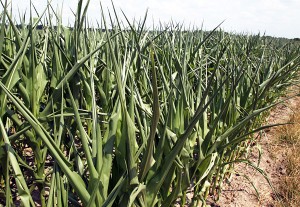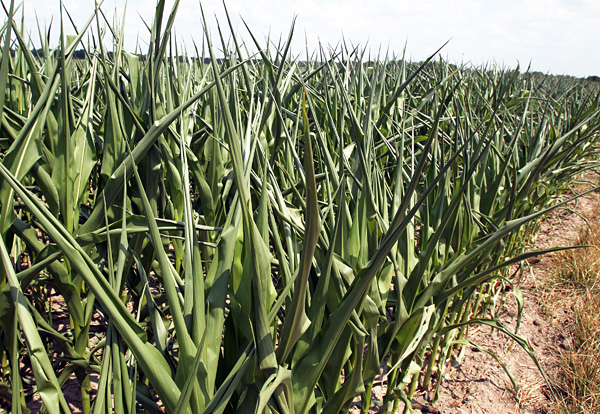 By Richard Meryhew, Star Tribune (Minneapolis) –
By Richard Meryhew, Star Tribune (Minneapolis) –
COCHRANE, Wis. — Rain finally fell on Wisconsin’s bluff country this week, but for much of the corn on Keith Greshik’s 900-acre farm, it was too little too late.
Stalks that should be lush, green and 10 feet tall are brown and crisp and barely as high as the bill on Greshik’s cap. Fields that only a month ago held potential for substantial yields are now nearly a total loss, withered by five weeks of stifling heat and dry weather the likes of which southwestern Wisconsin hasn’t seen in decades.
“This stuff isn’t going to amount to anything,” a discouraged Greshik, 43, said the other day as he inspected his battered corn in the July sun and heat. “It’s done.”
Bad as the drought is here in Buffalo County, it pales compared to what has gripped other parts of the state and much of the Upper Midwest, which is suffering through one of the driest growing seasons in nearly a half century.
More than two-thirds of the nation’s bread basket — from Kansas to Indiana — has gone without rain for much of the summer, destroying or damaging corn, soybean and alfalfa fields and costing farmers millions of dollars in lost yields.
As of Friday, the U.S. Drought Monitor showed more than half of the Midwest, which produces most of the nation’s corn and soybeans, was suffering from “severe” to “extreme” drought.
Southern Wisconsin, from the Mississippi River east to Lake Michigan, was so desperate for rain that late last week, Gov. Scott Walker sought federal disaster assistance for 23 drought-stricken counties. More could be added to the list if much-needed rain doesn’t fall soon — and steadily.
“It’s kind of a crapshoot, and it’s part of farming,” Greshik said, trying to stay optimistic. “You don’t get to do well every year.”
But, he added, “if it doesn’t rain, we’re going to be in real trouble. I mean really in trouble.”
By late Tuesday, as much as two inches of rain had fallen across some of the driest stretches of southern Wisconsin. But for many farmers, it brought little relief.
“Right now, that doesn’t do much for them,” said Tom Stangeland of the National Weather Service in La Crosse, Wis. “It keeps the fire danger down, and lawns perk up a little bit. But for some of those people, like the corn growers, the crop is gone now.”
Ed Hopkins, assistant state climatologist in Madison, Wis., said the drought could be the worst “going back to the 1930s.”
As of Monday, more than half the state remained “abnormally dry” or worse. Only 5 percent of the state’s farmland had an “adequate” level of soil moisture, according to the state’s crop report. Most areas are short or “very short” of moisture, Hopkins said.
It’s just as bad in parts of Indiana, Illinois and Missouri.
Most of Iowa, the country’s top corn and soybean grower, is suffering from severe drought. Two thirds of Kansas is extremely to exceptionally dry. Parts of southwestern and northwestern Minnesota are moderately dry, but for the most part, the state is faring better than Wisconsin.
Buffalo County, a rolling stretch of countryside hugging the Mississippi about two hours southeast of the Minneapolis-St. Paul area, has fared better, too, than counties farther south and east. Still, local farmers say the drought of 2012 is easily the worst since 1988.
Carl Duley, the Buffalo County agricultural extension agent, said he plans to visit farms later this week to assess damage.
“Right now, we haven’t even made a guess on losses,” he said. Even with Tuesday’s rain, “there is some of that corn that is not going to do anything no matter how much rain we get now.”
The misfortune is a cruel twist to a growing season that had started so well.
So much rain fell across the valley in April and May that farmers here were optimistic.
“It took off great,” said Roger Bechly, who farms 355 acres near Fountain City, Wis. “It looked promising.”
Four inches of rain fell in mid-June.
And then it stopped. From June 20 through Tuesday, Buffalo County got barely a drop.
Bechly, Greshik and neighbors watched the weather reports and the skies daily, hoping for the best.
A storm system held promise a few weeks back as it moved across southeastern Minnesota. But when it hit Wisconsin, Greshik said, it “dried up at the river.” It later “reformed and dropped more rain” east of Buffalo County, he said.
“It just seems like that’s how it’s been all summer,” Greshik added. “We’ve got like the Bermuda Triangle of rain here.”
Temperatures in the upper 90s with a heat index in the 100s compounded troubles.
Corn planted in clay or “heavier” soil, which holds water, fared better. But much of the corn planted in sandier soil near the river shriveled up before it could pollinate.
“I’ve never seen corn go from being lush to rolling over in such a short period of time,” Greshik said.
Alfalfa fields have gone largely dormant, too. The thin crop has left local dairy farmers with less hay to feed cattle.
“You’ve got to take the good with the bad,” said Loren Wolfe, 70, who runs a 550-dairy farm near Waumandee, Wis. with John and Nettie Rosenow. “You try to do the best you can, but Mother Nature is still sort of in charge.”
As storms rolled across much of southern Wisconsin Tuesday, Greshik’s mood was more upbeat. He said the rain would “kick start” the flowering soybeans, which had started to yellow in some fields.
“It’s going to stop our hurt,” he said. “If we get another inch, and that would be asking a lot, we’ve got a lot here to really help us along.”
Greshik figures about one-third of his corn, lush from irrigation, is in good shape. About 20 percent, however, will be lost or severely damaged.
“It’s almost more frustrating to get the rain once your corn is shot,” said Rita Arcand-Greshik, Keith’s wife. “You sit there thinking ‘If we’d only got this a month ago.’ ”
Bechly, who farms about a mile south of Greshik, wonders the same. He said this week that most of the 160 acres of corn he planted is probably too far gone. He has crop insurance, he said, but it won’t make up for the loss. To help ease the financial hit, he sold a field cultivator and corn wagon this week to pay his fertilizer and crop insurance bills.
“I’ve been living here 55 years, so you know it’s part of the cycle,” he said of the wicked dry spell. “But it does hit ya. You see the crop burning up out there and you know that’s what you are relying on for income. It does wear on you, yeah.”








I’m having a hard time feeling sorry for these millionaire farmers who know exactly what they are up against every year.
I looked around yesterday at fields in the county. I noted two that had sprinklers running, and that corn was not looking all that good, but perhaps it will come back. It all seemed to depend on the soil types. Overall, there were a lot of fields that would survive with yield loss, more than the brown fields.
A field fire right now would be disasterous.